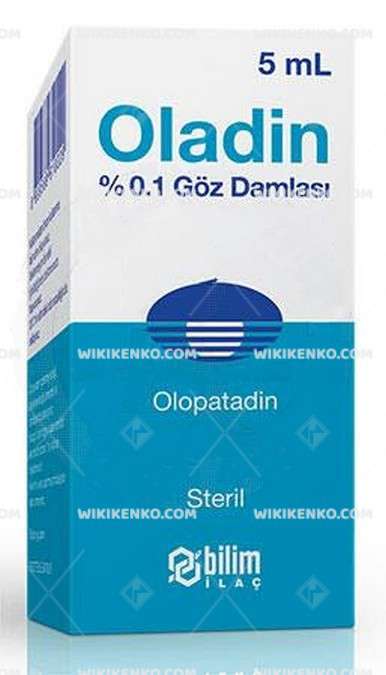Oladin Eye Drop, Solution
In the realm of ocular health, Oladin Eye Drop takes the spotlight as a sterile eye drop solution, a potent contender against the vexing symptoms of seasonal allergic conjunctivitis. Allergic conjunctivitis, triggered by common allergens like pollen, house dust, or animal fur, manifests as the dreaded trio of eye swelling, redness, and relentless itching. Oladin Eye Drop, with its 0.1% olopatadine composition, emerges as a valuable ally, working diligently to alleviate these discomforts.
| Dosage form | |
|---|---|
| Pack size | |
| Potency | %0.1 5Ml |
| Manufacturer | |
| Origin | |
| Generic Name (Ingredient) | Olopatadine Hydrochloride (Equivalent To 1 Mg Olopatadine) 1.11 Mg / Ml |
Assuming your emergency circumstances for this product, visit Urgent Quotation page. Besides, for any pharmaceutical questions, please ask us in the comments section.
Description
Ingredients
Oladin Eye Drop’s active ingredient is olopatadine hydrochloride, equating to a concentration of 1 mg/mL olopatadine. Beyond the active component, the formulation incorporates vital excipients, including benzalkonium chloride, dibasic sodium phosphate anhydrous, sodium chloride, hydrochloric acid, sodium hydroxide, and water for injection. These elements synergize to create a balanced and efficacious solution.
Application
Oladin Eye Drop is tailored exclusively for ocular use. To ensure a seamless experience, meticulous perusal of the usage instructions is paramount. It’s essential to adhere to the prescribed dosage meticulously, avoiding deviations from your healthcare provider’s recommendations. The significance of this precision cannot be overstated, as it underpins the medication’s effectiveness.
Precautions
A pivotal facet of Oladin Eye Drop’s usage lies in recognizing the precautionary measures. Individuals with allergies to olopatadine or any of the associated ingredients should steer clear of this medication. Moreover, breastfeeding individuals should seek counsel from their healthcare provider before considering its usage. Oladin Eye Drop is also not intended for children under the age of 3.
Oladin Eye Drop Side Effects
As with any medication, Oladin Eye Drop may present side effects, albeit generally mild and transient. These may encompass eye irritation, blurred vision, dry eye, headache, eye pain, and eye discomfort. In most cases, these side effects dissipate independently. However, should they linger beyond a reasonable duration, consulting a healthcare professional is advisable.
Dosage
The recommended dosage for Oladin Eye Drop revolves around applying a single drop in the affected eye(s) twice daily, with an approximate 8-hour gap between administrations. Adherence to the directives outlined by your healthcare provider or pharmacist is pivotal. Any queries or concerns regarding the dosage should be directed to your healthcare provider for clarity and reassurance.
Duration
The tenure of Oladin Eye Drop usage hinges on individual circumstances and the gravity of symptoms. It is essential to adhere to the regimen articulated by your healthcare provider or pharmacist. If, at any point, symptoms persist or worsen, a consultation with your healthcare provider is prudent. Their expertise can guide the way forward, ensuring the most appropriate course of action.
Conclusion
In summation, Oladin Eye Drop stands as a reliable solution in the realm of allergic conjunctivitis management. Its precision in targeting ocular discomfort is emblematic of pharmaceutical excellence. However, as with any medication, meticulous adherence to guidelines, dosage, and precautionary measures is the cornerstone of a successful therapeutic journey. In embracing these principles, individuals can look forward to the potential relief and comfort that Oladin Eye Drop offers in the battle against allergic conjunctivitis.
Use the form below to report an error
Please answer the questions as thoroughly and accurately as possible. Your answers will help us better understand what kind of mistakes happen, why and where they happen, and in the end the purpose is to build a better archive to guide researchers and professionals around the world.
The information on this page is not intended to be a substitute for professional medical advice, diagnosis, or treatment. always seek the advice for your physician or another qualified health provider with any questions you may have regarding a medical condition. Always remember to
- Ask your own doctor for medical advice.
- Names, brands, and dosage may differ between countries.
- When not feeling well, or experiencing side effects always contact your own doctor.
Cyberchondria
The truth is that when we’re sick, or worried about getting sick, the internet won’t help.
According to Wikipedia, cyberchondria is a mental disorder consisting in the desire to independently make a diagnosis based on the symptoms of diseases described on Internet sites.
Why you can't look for symptoms on the Internet
If diagnoses could be made simply from a textbook or an article on a website, we would all be doctors and treat ourselves. Nothing can replace the experience and knowledge of specially trained people. As in any field, in medicine there are unscrupulous specialists, differences of opinion, inaccurate diagnoses and incorrect test results.



Reviews
There are no reviews yet.